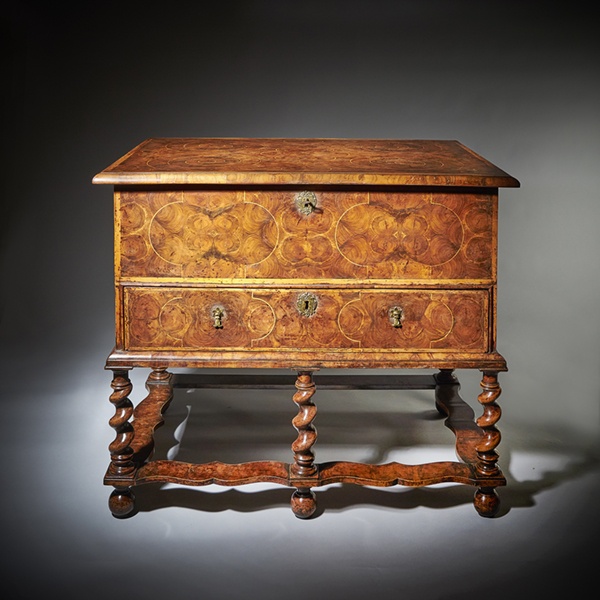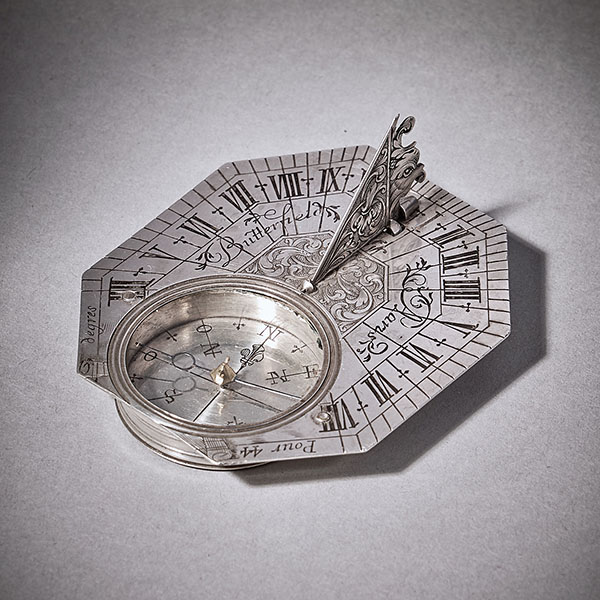A Fine William and Mary 17th-Century Olive Oyster Lace Box
Sold
Request Information
Follow Us
A Fine William and Mary 17th-Century Olive Oyster Lace Box
A Fine Late 17th Century Olive Oyster ‘Lace Box’ of Small Proportions. Circa 1680-1690 England.
The cross-grain moulded and holly banded top is finely veneered in hand-cut pieces of olive cut horizontally, known as ‘olive oyster veneering’. A roundel using this technique is placed in the centre of the top, bordered with a line stringing of holly, a further outer ring of oysters is also line strung and four large oysters sit to each corner. Raised on its original slot hinges, the cleated top appears to retain the original red japanned interior as does the base.
Similarly, the cross-grain moulded frieze is veneered in olive to the sides and face but, this time, hand-cut sections of figured olive. The back is veneered in lacewood. Raised on its original slot hinges the cleated top appears to retain the original red japanned interior as does the base.
Condition
Good. Wear consistent with age and use. Truly outstanding and original. Lovely colour and patination throughout.
Dimensions
Height: 3.15 in. (8 cm)
Width: 11.82 in. (30 cm)
Depth: 9.85 in. (25 cm)
PREVIOUSLY SOLD
No Results Found
The page you requested could not be found. Try refining your search, or use the navigation above to locate the post.
No Results Found
The page you requested could not be found. Try refining your search, or use the navigation above to locate the post.
YOU MAY ALSO LIKE

18th Century George III Mahogany Wine Cooler or Cellarette
18th Century George III Mahogany Wine Cooler or Cellarette £4,600Follow Us18th Century George III Mahogany Wine Cooler or Cellarette A fine and well-figured George III mahogany hexagonal wine cooler or cellarette on the original stand, C....

Striking 19th Century Carriage Clock with a Gilt-Brass Corniche Case by Grohé
Striking 19th Century Carriage Clock with a Gilt-Brass Corniche Case by Grohé £3,995 Follow UsStriking 19th Century Carriage Clock with a Gilt-Brass Corniche Case by Grohé Striking carriage clock with a gilt-brass corniche case by Grohé,...

A fine and extremely rare 17th century William and Mary baroque olive oyster chest on stand or ‘table box’, circa 1675-1690.
A fine and extremely rare 17th century William and Mary baroque olive oyster chest on stand or 'table box', circa 1675-1690. £12,600 Follow UsA fine and extremely rare 17th century William and Mary baroque olive oyster chest on stand or...

Rare Silver Pocket Sundial and Compass by Michael Butterfield, Paris, circa 1700
Rare Silver Pocket Sundial and Compass by Michael Butterfield, Paris, circa 1700 £4,900 Follow UsRare Silver Pocket Sundial and Compass by Michael Butterfield, Paris, circa 1700 A beautiful, rare solid silver Anglo-French octagonal pocket...

Engraved Eight-Day Striking and Repeating Carriage Clock by Perregaux Au Locle
Engraved Eight-Day Striking and Repeating Carriage Clock by Perregaux Au Locle Follow UsEngraved Eight-Day Striking and Repeating Carriage Clock by Perregaux Au Locle The superb engraved gilt gorge brass case has facetted glass panels to all...

Fine George III 18th Century Period Mahogany Longcase Clock by Tomas Fowle
18th Century Period Mahogany Longcase Clock by Tomas Fowle £12,995 Follow Us18th Century Period Mahogany Longcase Clock by Tomas Fowle A fine George III period mahogany longcase clock of excellent colour, patination and proportions, circa...

18th Century George III Mahogany Wine Cooler or Cellarette
18th Century George III Mahogany Wine Cooler or Cellarette £4,600Follow Us18th Century George III Mahogany Wine Cooler or Cellarette A fine and well-figured George III mahogany hexagonal wine cooler or cellarette on the original stand, C....

Striking 19th Century Carriage Clock with a Gilt-Brass Corniche Case by Grohé
Striking 19th Century Carriage Clock with a Gilt-Brass Corniche Case by Grohé £3,995 Follow UsStriking 19th Century Carriage Clock with a Gilt-Brass Corniche Case by Grohé Striking carriage clock with a gilt-brass corniche case by Grohé,...

A fine and extremely rare 17th century William and Mary baroque olive oyster chest on stand or ‘table box’, circa 1675-1690.
A fine and extremely rare 17th century William and Mary baroque olive oyster chest on stand or 'table box', circa 1675-1690. £12,600 Follow UsA fine and extremely rare 17th century William and Mary baroque olive oyster chest on stand or...

Rare Silver Pocket Sundial and Compass by Michael Butterfield, Paris, circa 1700
Rare Silver Pocket Sundial and Compass by Michael Butterfield, Paris, circa 1700 £4,900 Follow UsRare Silver Pocket Sundial and Compass by Michael Butterfield, Paris, circa 1700 A beautiful, rare solid silver Anglo-French octagonal pocket...

Engraved Eight-Day Striking and Repeating Carriage Clock by Perregaux Au Locle
Engraved Eight-Day Striking and Repeating Carriage Clock by Perregaux Au Locle Follow UsEngraved Eight-Day Striking and Repeating Carriage Clock by Perregaux Au Locle The superb engraved gilt gorge brass case has facetted glass panels to all...

Fine George III 18th Century Period Mahogany Longcase Clock by Tomas Fowle
18th Century Period Mahogany Longcase Clock by Tomas Fowle £12,995 Follow Us18th Century Period Mahogany Longcase Clock by Tomas Fowle A fine George III period mahogany longcase clock of excellent colour, patination and proportions, circa...









